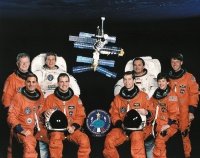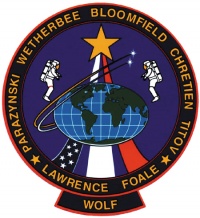STS-86
From The Space Library
 | |
| Organization | NASA-Office of Space Flight (United States) |
|---|---|
| Mission type | Human Crew,Microgravity |
| Launch date | September 26, 1997 |
| Launch vehicle | Space Shuttle |
| Launch site | Cape Canaveral, United States |
| COSPAR ID | 1997-055A |
| Inclination | 51.6 degrees |
| Experiments | Here |
| Alternate Names | 24964 |
| Additional Information | Here |
| Data Collection | Here |
| Payload Mass Up | 9312.7 kg |
| Payload Mass Down | 9126.82 kg |
| Orbiter | Atlantis |
| Lift Off Mass | 2,051,944.55 kg |
| Orbiter Weight at Liftoff | 114,326.36 kg |
| Orbiter Weight at Landing | 97,263.18 kg |
| Landed | Concrete runway 15 at Kennedy Space Center, Fla. |
| Orbits of Earth | 170 |
| Orbital Altitude | 213 nautical miles (245 statute miles) |
Contents |
[edit] Crew
- Commander: James D. Wetherbee
- Pilot: Michael J. Bloomfield
- Payload Commander:
- Mission Specialist 1: Vladimir Georgievich Titov, Russian Space Agency
- Mission Specialist 2: Scott E. Parazynski
- Mission Specialist 3: Jean-Loup J.M. Chretien, French Space Agency
- Mission Specialist 4: Wendy B. Lawrence
- Mission Specialist 5:
- Payload Specialist 1:
- Payload Specialist 2:
ISS/Mir Crew Transport
- David A. Wolf - up only C. Michael Foale - down only
[edit] Mission
STS 86, the 7th Mir Docking mission, carried a Spacelab double module for a docking with Mir, cargo transfer and an astronaut exchange. The previous Mir docking missions were STS 71, 74, 76, 79, 81 and 84. Highlights of the 10-day mission included five days of docked operations between Atlantis and Mir and the exchange of crew members Foale and Wolf to continue a permanent American presence on the Russian complex. A spacewalk was scheduled to retrieve the four Mir Environmental Effects Payloads which were attached to the Mir's docking module by Linda Godwin and Rich Clifford during STS 76 to characterize the environment surrounding the space station. Atlantis carried the Spacelab double module to support the transfer of logistics and supplies for Mir and the return of experiment hardware and specimens to Earth. The crew consisted of the following: James D. Wetherbee - Commander Michael J. Bloomfield - Pilot Vladimar G. Titov - Mission Specialist Scott E. Parazynski - Mission Specialist Jean-Loup Chretien - Mission Specialist Wendy B. Lawrence - Mission Specialist David A. Wolf - Mission Specialist
[edit] EVA
Extravehicular Activity (EVA) conducted by Scott Parazynski and Vladimir Titov, 5 hours, 1 minute. During this first U.S. spacewalk to include participation by a foreign astronaut, Parazynski and Titov retrieved MEEP and tested hardware for future EVA activities, including an evaluation of the Simplified Aid for EVA Rescue (SAFER), a small jet-backpack designed for use as a type of life jacket during station assembly. They also retrieved a solar array cap to be placed on the damaged Spektr module to the exterior of the docking module.
[edit] Payload
SPACEHAB double module/Mir 07; transfer tunnel; transfer tunnel extension; orbiter docking system; RME1314: European Space Agency Proximity Operations Sensor (EPS); Seeds in Space (SEEDS) II; MEEP carriers; Shuttle-Mir Mission 07 middeck science; Cosmic Radiation Effects and Activation Monitor (CREAM); KidSat; Commercial Protein Crystal Growth (CPCG); Cell Culture Module (CCM) A; Risk Mitigation Experiments
[edit] Books about the Space Shuttle Program
Buy This Book Click here |
Buy This Book here |
Buy This Book Click here |
Buy This Book Click here |





